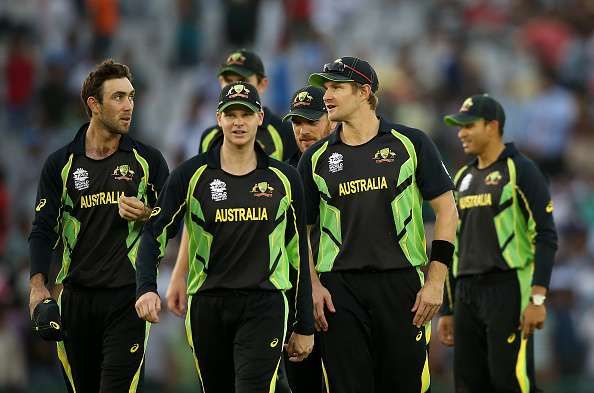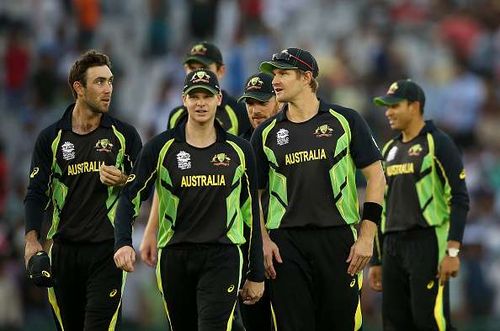
Will India use the 'Australian brand of cricket' against them in the World T20?
What is the 'Australian brand of cricket'? It means different things to different people. Some may say it is playing with all-out aggression. Some would say it's about being completely ruthless and intimidating, both on and off the field. And some would say it's about unswerving professionalism and dedication.
The Australians have used their unique 'brand' to achieve a lot of success over the years. But in recent times, the uniqueness of their cricket seems to be diminishing; not only have they gone a little softer themselves, but other teams have also started using aggression to good effect against them.
The IPL has changed everything
I attribute a lot of that to the rise and expansion of the IPL. Before the IPL started, the Australians used to have just one thing on their mind - winning. They were not into making friends off the field, hanging out with their peers from other countries, or giving much thought to the opposition at all.
They were all about winning, and winning by any means - whether it was through mind games, sledging or superior cricket.
But now, things have changed. India are the financial superpower in cricket, and the IPL is the biggest money-spinner around. Several members of the Australian national team ply their trade in India’s domestic league, which means they can’t be too aggressive when they take the field against India.
The likes of Steven Smith, Mitchell Starc, etc. know that they have to come back to India and play under Indian captains like MS Dhoni and Virat Kohli. That makes them reluctant to be ruthless and in-your-face during international games, the way they have been throughout their history.
They try their hardest to be nice to everyone on social media, and they always show respect for players like Dhoni and Kohli. The Australian players don’t care just about winning anymore; they also care about their image, and about maintaining cordial relations with their Indian counterparts.
Indians have adopted some of Australia’s tactics in recent times
Has the Australians’ newfound ‘niceness’ made their team easier to defeat? They certainly haven’t been as successful in recent times as they were a decade ago, but that could also be attributed to the lack of world-class players in the side.
What is undeniable, however, is that other teams around the world have become thoroughly accustomed to the ‘Aussie brand’ of cricket, to the extent that they now use some of their own tactics against them.
We’ve all seen Kohli, Rohit Sharma and Ishant Sharma give back as good as they get when they play against Australia. No sledge is taken quietly anymore; if anything, sometimes Indian players themselves instigate the ‘mental disintegration’ episodes with their verbal attacks.
India’s aggression is reflected in their cricket too. Part of that has to do with the advent of T20; when you know you have no option but to score quickly, you do anything in your power to attack the bowlers.
This may sound like a generalization, but Indian players have not been known to be inherently aggressive. Our greatest legends – Sachin Tendulkar, Rahul Dravid, Anil Kumble, Javagal Srinath – always preferred to let their cricket do the talking. They used their skills more than anything else to win matches, and sometimes that would make them seem less aggressive.
But the less-skilled players couldn’t always let their cricket speak for them, and so they suffered. There was a time when Australian bowlers like Brett Lee, Glenn McGrath, Mitchell Johnson etc. inspired fear among some of the Indian batsmen. But now, with T20 matches becoming so common, especially in the IPL, Indians have learned how to deal with these fearsome bowlers.
They now try out a variety of different shots to get the better of the opposition – reverse sweeps, scoops over the keeper’s head, dabs to the third man boundary are just a few of them. These kind of shots have the effect of damaging the bowler’s ego, which is another reason why Australian players don’t have very inflated egos anymore.
Moreover, when Indian players train alongside legends like Lee, Gayle and De Villiers, they learn how to deal with the genius of international players. Jasprit Bumrah has said that he was greatly helped by the presence of Lasith Malinga in the Mumbai Indians team. The same goes for the youngsters in the other IPL teams.
All this means that when India take the field against Australia in Mohali, they will not be intimidated by Steven Smith’s team. The Australian team doesn’t inspire fear among Indians anymore, and we have both the IPL and the inherent aggression of our new generation of players to thank for that.
What kind of pitch would be ideal for India in Mohali?
So far we’ve seen India play all their matches on slow wickets, and that hasn’t helped them much. The bowlers have been doing well, but it must be noted that India’s attack consists of bowlers who can perform on any wicket.
The Ring Leader Ashwin can certainly trouble the batsmen on any kind of wicket in T20. And even Bumrah doesn’t really swing the ball a lot, so the pitch doesn’t matter to him all that much.
But for the batsmen, the pitch has become very important. The Indian lineup has a lot of players who can win matches on their own – Rohit, Dhawan, Raina and Yuvraj are all game-changers, in addition to Kohli who is arguably the best batsman in the world. But these players, apart from Kohli, need a helpful pitch to produce the goods.
So ideally, Dhoni would want to see a batting wicket in Mohali. But irrespective of what the captain thinks, I’m 100% sure that Mohali’s curator Daljit Singh will look to create a sporting wicket with even bounce and good pace.
Daljit Singh is the kind of curator who likes to see the fast bowlers getting some help from the wicket. He likes to leave plenty of grass and moisture on the pitch, so that the ball zips around with pace. Since this is a T20 match he will probably not leave as much grass or moisture for Sunday’s match, but I’m confident he will ensure that the wicket is not slow.
As a side note, Nehra can be quite devastating if there’s some grass on the pitch, because he can generate a lot of swing with his unique left-arm action. So if the pitch IS on the quicker side with some grass on it, Dhoni shouldn’t be too unhappy about it.
Prediction:
India has a good T20 record against Australia, having whitewashed them at home earlier this year. And the current Australian team is very similar to the one that India defeated. That instantly gives Dhoni’s men the advantage.
I feel the Australians don’t have the ideal approach to T20 cricket. They make a lot of mistakes in their team combination, and right now their bowling attack is not great. Their on-field decisions can also be bizarre at times; Smith giving Ashton Agar the 3rd over against New Zealand was a big tactical blunder.
They do have plenty of firepower in their batting lineup, but so do India. I’d say India’s and Australia’s batting are at par, but India’s bowling is better. Nehra, Bumrah, Ashwin and Jadeja are all comfortable in their roles, but for Australia, apart from Zampa, the rest of the bowling hasn’t really looked threatening on these pitches.
It’s a little clichéd to say this, but whoever makes less mistakes on the day will win. If the wicket is true and sporting, India have the edge. But things are never as simple as that.
Dhoni knows that his team can’t get away with goof-ups like they made against Bangladesh – not against a team like Australia. And Smith knows that his batting can’t afford to collapse against India, the way it did against New Zealand and Bangladesh.
All said and done, I give India a 60% chance of winning. And as we all know, if that prediction comes true, India will be through to the semifinals. It’s always a confidence booster to progress after defeating a tough team like Australia!

